The Ariane 5
This page is a work in progress
Arianespace has produced a number of different versions of the Ariane 5. This page describes each version and their differences. I started this page as a resource for modellers who want to build an accurate model of the Ariane 5, so that's where the focus will be.
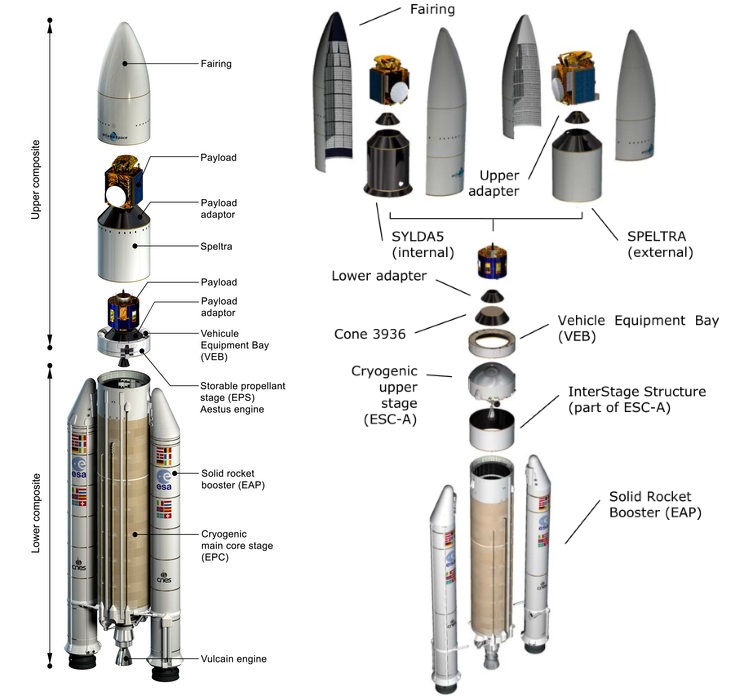
On the left, the Ariane 5G (diagram from the ESA media archive), on the right the ECA (Ariane 5 User's manual, Issue 4).
Versions of the Ariane 5:| Version | Notes |
|---|---|
| G | Initial version |
| G+ | Small increase in capacity for EPS |
| ECA | New second stage using a higher-performance engine borrowed from Ariane 4. |
| ECB | Proposed ultimate version, with even higher performance than ECA, and a restartable engine. Cancelled before it reached production. |
| GS | Emergency version, after the failed first launch of the ECA. |
| ES ATV | A mix of G+ and ECA elements to enable heavy missions to LEO |
| ES Galileo | A mix of G+ and ECA elements to enable light missions that deploy multiple satellites. |
| ME | Final version, proposed to increase performance and lower costs until Ariane 6 reached production. Cancelled before it reached production. |
Ariane 5 G and G+
This is the initial version (G = Generic), used from its introduction in 1996 to 2000.
Main components:
- First stage, the EPC H155 (hydrogen, 155 tons of propellants), using a Vulcain 1 engine. The Vulcain runs on oxygen and hydrogen. EPC = Etage Principal Cryotechnique, Cryogenic Main Stage.
- Solid boosters: EAP-238 (238 tons of propellant). EAP = Etage d'Acceleration à Poudre, Solid/Powder Acceleration Stage.
- Second stage: the EPS9.7, using an Aestus engine. It contains 9.7 tons of hypergolic propellants. EPS = Etage à Propergols Stockables, Stage with Storable Propellant.
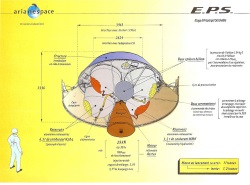
EPS - The second stage is installed inside/on top of the VEB (Vehicle Equipment Bay, Case à équipement). The VEB contains the avionics, the attitude control system and the stage separation rockets.
- The fairing contains the payload.
Norbert Brugge's list of Ariane 5 launches indicates that the first 7 launches used another variant named "Ariane 5". This used EAP-236 boosters instead of EAP-238. I don't see this mentioned in other sources though.
In 2004, the Ariane 5G+ was used 3 times. This had an EPS10 stage (with 10t of propellants), and was otherwise identical to the 5G.
Ariane 5 ECA
The ECA was a major upgrade, although intended as an interim version at the time. Its first flight was in 2002, unfortunately this ended in failure and it would take 3 years until the next flight. At the time, it was planned to replace the ECA with the ECB version in a few years.
Changes for this version:
- A modified first stage, the EPC H173, including a new engine (Vulcain 2).
- New solid boosters, the EAP-241 (later missions used the EAP-241A).
- A new second stage, the ESC-A.
Source: Capcomespace
ECA first stage: EPC H173
- The first stage has a new engine, the Vulcain 2. This has 22% more thrust than the Vulcain 1.
The main visible difference is the turbopump exhausts: on the Vulcain 2 the exhausts are connected to a ring on the nozzle,
the exhaust is vented through the nozzle to provide film cooling of the nozzle walls.
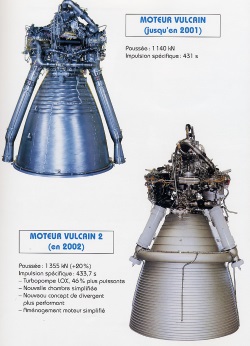
EPS
- The new engine uses a different oxidizer:fuel ratio, 7.2 instead of 5.9. The bulkhead between the first stage tanks has been moved to get the correct tank sizes. This means the total propellant load is now 173 tons. The height of the stage remains the same, to prevent major changes to the structure.
- the first ECAs used beige insulation (the same as was used on the 5G) on the first and second stage: missions V-157, 164, 167, 170-173, 175. On later missions, the insulation tiles are light blue instead.
- The first stage engine has one high-pressure helium tank instead of 2.
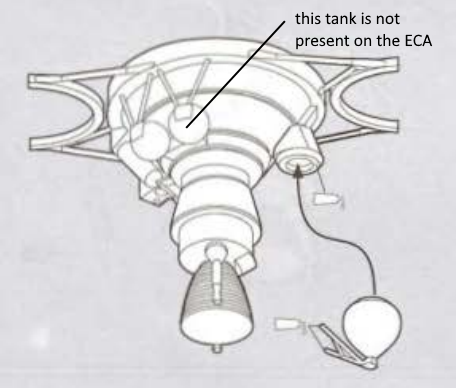
Solid boosters

The boosters were modified in two stages. First, the amount of propellant was increased by 3 t, this extra is installed in the top segment of the booster. The size of the booster remains the same. This version is called EAP-241. This was used on missions V-157, 164, 167, 170-173, 175, 182, 184-186, 189.
Later, the booster casings were modified to make the lighter. EAP-238 and 241 boosters each consist of 7 segments. The joints (visible as thicker bands on the model) are bronze (I think this is a metal hoop around the joint). These joints were changed: most of the booster segments are welded together in the factory, and the boosters are shipped in 3 parts, so 3 field joints remain. This reduced the weight by 1900 kg. This version of the booster is known as the EAP-241A. The welds are still visible as slightly thicker bands around the segment. They are painted white. These boosters were used on missions 174, 176, 177, 179, 183, 187, 188, 190 and all later flights.
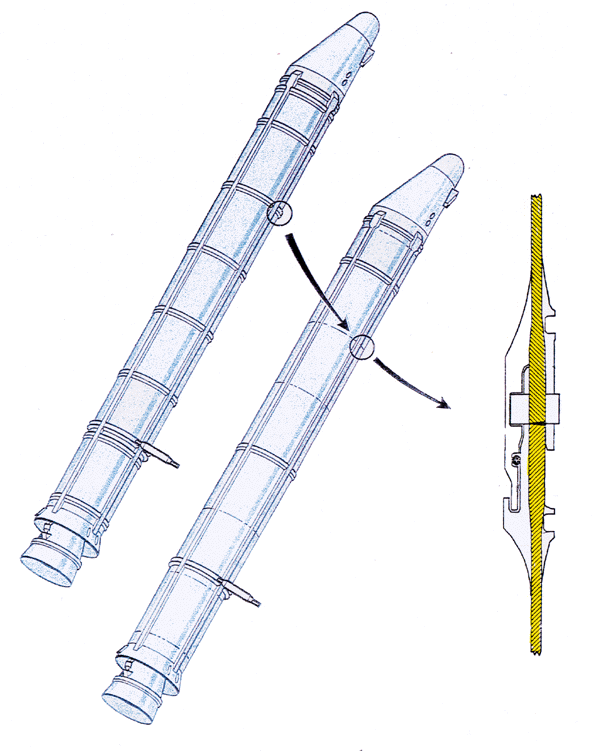
- The EAP-238 boosters have 2 hydraulic tanks (part 20) at the base of each booster (these provide power for the thrust vectoring system). On the EAP-241, this is replaced by a single, larger tank.
ESC-A second stage
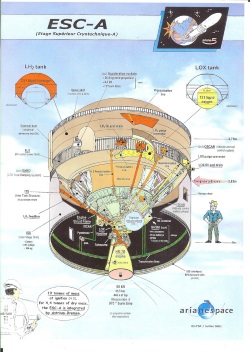
ESA wanted an upper stage with higher performance for GTO missions. The plan was to do this in two steps: first, develop an interim stage using existing components, this would be the ESC-A. Then, develop the final version ESC-B, which would require a new high-performance engine. ESC-A = Etage Supérieur Cryotechnique de type A, Cryogenic upper stage type A.
The ESC-A reused the HM7B engine from the Ariane 4, along with its thrust structure and the liquid oxygen tank. The hydrogen tank was new (due to the much larger diameter of the Ariane 5 compared to Ariane 4). This stage has a few drawbacks: the engine is not restartable, so there are missions it's not suitable for. Also, the structure of the stage is relatively heavy, which reduces performance.
The ESC-A is much larger than the EPS, so unlike the EPS it cannot be installed inside the VEB.
Ariane 5 GS
When the first launch of the Ariane 5 ECA failed, Arianespace only had ECA versions in production. Some of these were modified to use as much technology from the G version as possible, so missions could be launched while the ECA failure was investigated.
The GS used a first stage with a Vulcain 1 engine, EAP-238 boosters and an EPS second stage. The first stage tanks were taken from the ECA production line and modified to accept the Vulcain 1 (this included moving the bulkhead to get the correct tank sizes for the EPC155).
For modeling purposes, the GS looks identical to the G. The GS was used for these missions: V-166, 168, 169, 178, 180, 193.
Ariane 5 ES ATV and ES Galileo
The Ariane 5 ES ATV was a special version for launching the (heavy) ATV missions. On this version, the VEB structure was beefed up to cope with the load. The ES Galileo is used for the Galileo launches. It uses a lighter VEB structure. For scale modelling purposes, both look similar. Changes for this version:
- The first stage is an EPC H173, as on the ECA.
- The boosters are EAP-241A, as on the ECA.
- The second stage is an EPS.
An ES ATV being prepared for launch:
Ariane 5 ECB and ME
The Ariane 5 ECB was to be the ultimate Ariane 5 version: it would use a new, high-performance second stage with more propellant than the ESC-A, and a restartable engine called Vinci. The planned payload to GTO was to be 12 t. This project was cancelled in 2003, but development of the Vinci coninued at a low rate.
In 2012, the decision was taken to start development of Ariane 6, and in parallel look at improvements for the Ariane 5 (called Ariane 5 Midlife Evolution, or ME), with an eye on having commonality between the two. With a first flight planned for 2018, the ME would have become ESA's principal launcher (replacing the ES and ECA versions) until the arrival of the new Ariane 6 version. The requirements for the Ariane 5 ME were "more flexibility in accommodating payloads by way of a dual-launch configuration; an upper stage reignition capability for stage deorbiting to mitigate orbital debris; the capability to complete complex missions such as planetary exploration". This would be achieved by a new second stage using the restartable Vinci engine. A longer fairing (20 m) and a longer SYLDA (8 m) were planned to accommodate the larger geostationary satellites that were expected. This sounds very similar to the Ariane 5 ECB, but I haven't been able to confirm whether the ME design was to be identical to the ECB. In 2015, development of the 5 ME was stopped, and development effort switched to the Ariane 6.
Payload fairings
The fairing was made in 3 sizes (long, medium, short). In addition, cylindrical segments were available to extend the fairing (ACY, Adapteur CYlindrique = Cylindrical adapter). The ACY is available in 4 heights: 0.5, 1.0, 1.5 and 2.0 m.
Ariane 5 was designed to launch 2 satellites at a time, and 2 structures were built to facilitate this: SPELTRA (Structure Porteuse Externe Lancement Triple Ariane = Ariane Triple-Launch External Carrier Structure), and SYLDA (Système de Lancement Double Ariane = Ariane Double-Launch System). SYLDA is used more often than SPELTRA because it is lighter, but SPELTRA can accommodate larger satellites. SPELTRA has a diameter of 5.4 m, and the fairing would be placed on top of the SPELTRA. SYLDA has a smaller diameter, and fits inside the fairing.
Arianespace offers 3 fairing sizes. A longer fairing was planned for the ME version. As of version 5 of the user manual, the short and medium fairings are no longer mentioned, but the short version has been usd for Galileo missions in 2017 and 2018.
| Fairing | Total height | >
|---|---|
| Short | 12.58 m |
| Medium | 13.665 m |
| Long | 16.372 m |
| Longer | 20 m |
| SPELTRA 4160 | 4.897 m |
| SPELTRA 5660 | 6.397 m |
The SPELTRA can be combined with the short fairing.
Sources
List of all Ariane 5 launches, which shows which version was used for each launch: 'Space launch vehicles of the world', Norbert Brugge
CapcomEspace has photos of every launch, and a lot of information on the rocket and its development process, etc. The site is in French.
Bernd Leitenberger has a list of launches, development information, specifications etc. Leitenberger also wrote 2 books on the European space program. The site and books are in German.
